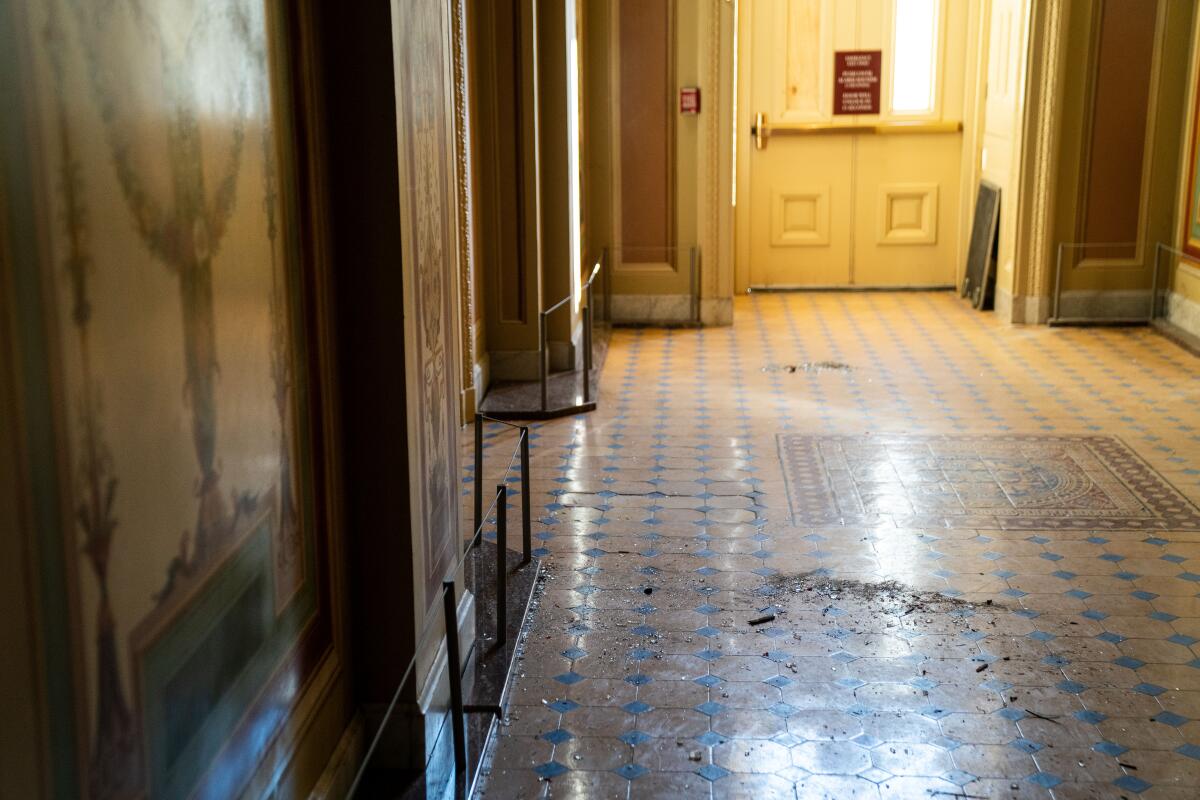Capitol Police Board won’t give inspector general details of post-Jan. 6 security upgrades

- Share via
WASHINGTON — The governing board that oversees security improvements to the U.S. Capitol refused to disclose to a government watchdog what improvements are being made after rioters were able to smash windows and enter the building Jan. 6, 2021, according to a watchdog report released Thursday.
The Los Angeles Times obtained a copy of the report detailing the inspector general’s attempts to get information in advance of its release.
In October, a Times investigation found that windows broken Jan. 6 were not reinforced during previous upgrades, making them particularly vulnerable to the mob. Other windows in the building and surrounding office buildings were upgraded to be shatterproof or bulletproof in the years after Sept. 11, 2001, and those survived the melee.
At the request of a member of Congress, Architect of the Capitol Inspector General Christopher P. Failla was investigating why some windows were vulnerable, and what security upgrades had been made since.
Failla was initially told the architect “could not respond to these questions without compromising physical security and classified programs, disregarding the Inspector General’s statutory authorities to receive all requested information regardless of classification,” according to the report.
His questions were referred to the three-member Capitol Police Board, made up of the architect of the Capitol, the House sergeant at arms and the Senate sergeant at arms. The board has final say over security changes at the Capitol, and it did allow the architect to provide some information, but Failla maintained that the incomplete answers hindered a more thorough examination of the related subject matter.
“We found that while all windows damaged on January 6, 2021 have been repaired, there are further security enhancements and repairs needed for U.S. Capitol windows,” Failla said in a letter to
Architect of the Capitol J. Brett Blanton that accompanied the report.
The U.S. Capitol should have “consistent ballistic protection” for all windows and entrances, he recommends in the report. The Capitol Police Board, including the architect, should also consistently upgrade its security strategy to address potential threats, not just respond to incidents that have recently occurred.
A spokesperson for the current chair of the board, House Sergeant at Arms William Walker, said Thursday that he was traveling and unavailable to comment.
Congress oversees the board, though it has operated largely autonomously for years until questions rose about its failures on Jan. 6. Its meetings are not open to the public, and no government inspector general has direct authority to examine its decisions.
Two windows and two doors used by Jan. 6 rioters were among only a few that weren’t reinforced during a Capitol security upgrade that started in 2017.
A spokesman for the House Administration Committee, one of two committees that oversee the board, indicated that Chair Rep. Zoe Lofgren (D-San Jose) expects the board to comply with the watchdog request.
“Chairperson Lofgren believes every organization should promptly cooperate and assist with all accredited investigations related to improving security at the United States Capitol,” spokesman Peter Whippy said.
Government inspectors general are tasked with identifying and investigating fraud, waste and mismanagement within government. Congress created the architect of the Capitol inspector general in 2007. Its reports are often made public and include a list of recommended solutions. Reports containing classified or highly sensitive information are often produced for lawmakers and others in power to review, but are not made available to the public.
The Times investigation found that the majority of the Capitol’s 658 single-pane windows were quietly upgraded during a 2017-19 renovation. Original wooden frames and glass were covered with a second metal frame containing bomb-resistant glass.
But planners skipped about a dozen ground-floor windows, including some located in doors, because they were deemed to be low risk in the event of implosion, largely due to their discreet or shielded location, or because the building couldn’t structurally handle the load of the heavier frames. Some windows on the second and third floors of the building, considered low risk for implosion, were also not reinforced.
Several of the vulnerable ground-floor windows and two glass-paned doors — protected by only a thin ballistic film added after the Sept. 11 terrorist attacks — became easy entry points for rioters on Jan. 6.
Capitol Police Chief J. Thomas Manger told reporters in January that windows would be upgraded at the Capitol this spring but provided no details of the location of the windows or to what standard windows would be updated.
Though Blanton, the architect of the Capitol, told House Appropriations Committee members days later that windows would be improved, the three-member Capitol Police Board would not give the architect inspector general any proof of new security measures being included in the new windows, including how the windows being replaced will be reinforced, or if they even will, the report stated.
Failla said that the board also did not provide information about how it would mitigate potential threats during the upgrade process. When he asked the architect to detail what would be considered in deciding whether to upgrade the windows — for example, the frame’s ability to hold heavy ballistic, bulletproof or shatterproof glass; or preserving the aesthetics of a historic building — he was told the Capitol Police Board considered “multiple factors” in its assessment.
The board and architect of the Capitol officials also did not answer the inspector general’s questions about window security upgrades after Sept. 11, 2001, and a spate of high-profile security incidents on Capitol grounds in 2017.
“They did not disclose this information or identify which windows at the U.S. Capitol were reinforced and to what level they were reinforced before the events at the U.S. Capitol on January 6, 2021,” Failla said in the report.
A fence currently blocks access to the vulnerable windows on the Capitol’s West Front, which were replaced with glass of unknown quality after the riot. Scaffolding has been erected against the building behind the fence.
More to Read
Get the L.A. Times Politics newsletter
Deeply reported insights into legislation, politics and policy from Sacramento, Washington and beyond. In your inbox twice per week.
You may occasionally receive promotional content from the Los Angeles Times.












